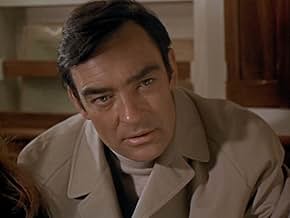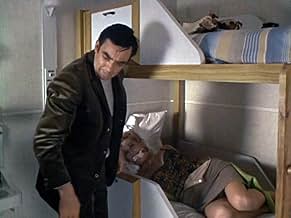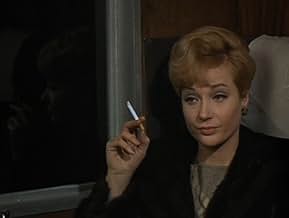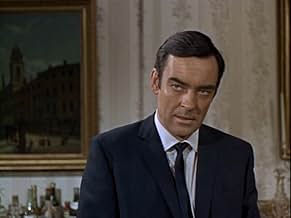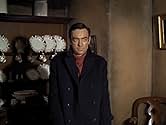IMDb-BEWERTUNG
5,6/10
539
IHRE BEWERTUNG
Füge eine Handlung in deiner Sprache hinzuDuring the Cold War, a British secret agent is ordered to kill a Soviet-bloc defector held by the CIA in England but this straightforward mission turns into a convoluted plot involving doubl... Alles lesenDuring the Cold War, a British secret agent is ordered to kill a Soviet-bloc defector held by the CIA in England but this straightforward mission turns into a convoluted plot involving double-agents.During the Cold War, a British secret agent is ordered to kill a Soviet-bloc defector held by the CIA in England but this straightforward mission turns into a convoluted plot involving double-agents.
- Regie
- Drehbuch
- Hauptbesetzung
Jim Tyson
- Bill, Landlord
- (Nicht genannt)
Empfohlene Bewertungen
. But worth noting for its star Richard Johnson and director Seth Holt. A former Royal Shakespeare Company actor, Johnson was Bond director Terence Young's original choice to play 007 and might have proved much closer to author Ian Fleming's concept of him. Indeed, Johnson was briefly groomed by the Rank Organisation in the late Sixties as their answer to Sean Connery, hoping to ride the Bond slipstream (but the two films Deadlier Than the Male and Some Girls Do were too cynically packaged to work as either imitation or spoof).
Johnson's brand of worried suavity found a better vehicle here. A minor addition to the murkier side of the genre, it remains most notable for Holt. A former editor, Holt's deft cutting room skills had made two suspense films he directed for Hammer (Taste of Fear and The Nanny) unusually seamless and subtle.
Alas, in Danger Route, even his assured touch failed to enliven an intractable plot about Cross-Channel espionage. But an exceptionally strong support cast - Harry Andrews, Diana Dors and Gordon Jackson - and a certain casual ruthlessness, lift this film above the totally routine. And Carol Lynley and Barbara Bouchet are truly gorgeous.
Trite cynicisms and a trashy title-song date Danger Route unsympathetically. But Holt's admirers will discern enough in its minor virtues to compensate.
Johnson's brand of worried suavity found a better vehicle here. A minor addition to the murkier side of the genre, it remains most notable for Holt. A former editor, Holt's deft cutting room skills had made two suspense films he directed for Hammer (Taste of Fear and The Nanny) unusually seamless and subtle.
Alas, in Danger Route, even his assured touch failed to enliven an intractable plot about Cross-Channel espionage. But an exceptionally strong support cast - Harry Andrews, Diana Dors and Gordon Jackson - and a certain casual ruthlessness, lift this film above the totally routine. And Carol Lynley and Barbara Bouchet are truly gorgeous.
Trite cynicisms and a trashy title-song date Danger Route unsympathetically. But Holt's admirers will discern enough in its minor virtues to compensate.
Richard Johnson is a hit man for British intelligence. Literally. He offs them with a karate chop to the neck. He's getting weary of the job and is thinking of leaving the profession when he gets another job. Whitehall wants a Soviet defector, but the Americans have him, so he needs killing. Johnson is assigned to the task. However things go awry. There's more at work than Whitehall setting policy.
There's a lot of Bondian elements here: the beautiful women, and so forth -- Carol Lynley, Barbara Bouchet and Sylvia Sims, and Diana Dors gets the cherished final spot on the credits. It's not just a Bondian romp at the peak of the 1960s spy craze. The darkness and betrayal lend a tinge of John Lecarre to the proceedings as Johnson slowly untangles the tangled web of the plot of the plot -- and finds himself snarled in its slubby mass at the end.
It a good performance and you can see why Johnson had been Terrence Young's first pick for playing Bond in DOCTOR NO. Although the movie works, his depressed character is, in the end, not terribly attractive; however, no one is.
There's a lot of Bondian elements here: the beautiful women, and so forth -- Carol Lynley, Barbara Bouchet and Sylvia Sims, and Diana Dors gets the cherished final spot on the credits. It's not just a Bondian romp at the peak of the 1960s spy craze. The darkness and betrayal lend a tinge of John Lecarre to the proceedings as Johnson slowly untangles the tangled web of the plot of the plot -- and finds himself snarled in its slubby mass at the end.
It a good performance and you can see why Johnson had been Terrence Young's first pick for playing Bond in DOCTOR NO. Although the movie works, his depressed character is, in the end, not terribly attractive; however, no one is.
The director had come down considerably in the world by the time he made this potboiler in colour for Amicus, but it does reflect the fatalism of his directorial debut 'Nowhere to Go' and is far from the dog's dinner Betty Box & Ralph Thomas made of their two films featuring Richard Johnson as Bulldog Drummond.
By this time the more squalid side of espionage was already becoming a commonplace - even if Johnson drives a car with personalised number plates and it boast a title song sung by Anita Harris and rather exotic sitar score by John Mayer - so in Holt's hands the violence is both far messier and more intimate than usual.
By this time the more squalid side of espionage was already becoming a commonplace - even if Johnson drives a car with personalised number plates and it boast a title song sung by Anita Harris and rather exotic sitar score by John Mayer - so in Holt's hands the violence is both far messier and more intimate than usual.
The title song for this movie reminds one of the middle James
Bond films--a catchy title woven into an incomprehensible song. Happily, things improve quickly. Jonas Wilde, the licensed killer, is dour and taciturn, but I was empathizing with him before too long. Jonas uses no outrageous stunts, no silly gadgets, and the movie was almost over when I was struck by the realization that there was not a single chase scene. Jonas does not even use a weapon, killing rather with a sharp blow to the neck (I would call it a Judo Chop, except I know nothing of Judo) This film was written so as to leave the way open for sequels; it is a loss none were made.
Bond films--a catchy title woven into an incomprehensible song. Happily, things improve quickly. Jonas Wilde, the licensed killer, is dour and taciturn, but I was empathizing with him before too long. Jonas uses no outrageous stunts, no silly gadgets, and the movie was almost over when I was struck by the realization that there was not a single chase scene. Jonas does not even use a weapon, killing rather with a sharp blow to the neck (I would call it a Judo Chop, except I know nothing of Judo) This film was written so as to leave the way open for sequels; it is a loss none were made.
Some years back, I had recorded this (on VHS) off the MGM cable channel but the reception had been so poor I did not make it through the film; eventually, I upgraded to a decent copy – albeit also sourced from MGM and, thus, panned-and-scanned! Anyway, I decided to check this out now (and the two remaining unwatched films from this promising but short-lived director) as a follow-up to star Richard Johnson's recently-viewed appearances – in the same mould – as Bulldog Drummond but also in anticipation of two upcoming Holt revisits in my ongoing tribute to the late Hammer scribe Jimmy Sangster. Still, unlike those two lightweight spy films, this is anything but campy or glossy; in fact, typical of most Cold War espionage yarns of its era (equating realism with glumness), the plot is fairly obscure, so that the result proves oddly unmemorable despite careful work all around!
It is therefore up to an impressive cast (in uniformly fine form) to deliver the goods and keep one watching: Johnson, Carol Lynley (as his two-timing girlfriend who tries to poison him at the end – but her fish get it instead! – and whom he fells with a karate chop!), Barbara Bouchet (as an initially suspicious addition to the spy ring but who ultimately emerges a heroic trooper and even loses her life to the 'cause'), Harry Andrews (as Johnson's suave superior), Gordon Jackson (as the hero's seemingly laid-back skipper-partner but who turns out to be opportunistic, duplicitous and sadistic), Sylvia Syms (as Andrews' nagging wife who gets abducted on a train by Johnson), Diana Dors (as a housekeeper to a defecting scientist seduced by Johnson in the guise of a salesman), Sam Wanamaker (as the C.I.A.'s top man dubbed "Lucinda" and Bouchet's boss) and Maurice Denham (as Johnson's elderly team-mate whose murder starts the ball rolling).
The film opens in a movie theater where one is given to understand that Johnson will himself be eliminated by his own side once he completes his next mission, but this does not happen (having discovered the mole in their organization) but is nonetheless kept on a leash by the umbrella-carrying Andrews in the freeze-frame finale (incidentally, Holt's start as an editor at Ealing Studios is much in evidence here as the film's pacing is very tight, with scenes hardly being allowed to finish off or permitted to start gradually)! Apparently, Johnson was Terence Young's first choice to play James Bond but, as I said earlier, his world-weary 'eliminator' (the title of the original source novel) here is closer to the austerity of Harry Palmer. Johnson and Bouchet were once a romantic item and, as it happens, they probably both owe their popularity in cult movie circles today to Italian film-maker Lucio Fulci via, respectively, ZOMBIE (1979) and DON'T TORTURE A DUCKLING (1972)!
Interestingly enough, Holt (who worked for Hammer 3 times) is here employed by their main rivals, Amicus; for the record, he had already dabbled in the spy world by directing episodes of TV's DANGER MAN (1960-61) and ESPIONAGE (1964). The film under review – which the director apparently dismissed as "dreadful" and claimed he only made it because he "needed the bread"! – is Holt's final completed work (in the U.S. it was unceremoniously released as a double-feature, incongruously paired with Paul Wendkos' second-rate war movie ATTACK ON THE IRON COAST {1968}!), since alcoholism got the better of him dying at the young age of 47 two-thirds of the way through shooting Hammer's superior BLOOD FROM THE MUMMY'S TOMB (1971)!; even so, Johnson later named him one of the best taskmasters he ever worked for.
It is therefore up to an impressive cast (in uniformly fine form) to deliver the goods and keep one watching: Johnson, Carol Lynley (as his two-timing girlfriend who tries to poison him at the end – but her fish get it instead! – and whom he fells with a karate chop!), Barbara Bouchet (as an initially suspicious addition to the spy ring but who ultimately emerges a heroic trooper and even loses her life to the 'cause'), Harry Andrews (as Johnson's suave superior), Gordon Jackson (as the hero's seemingly laid-back skipper-partner but who turns out to be opportunistic, duplicitous and sadistic), Sylvia Syms (as Andrews' nagging wife who gets abducted on a train by Johnson), Diana Dors (as a housekeeper to a defecting scientist seduced by Johnson in the guise of a salesman), Sam Wanamaker (as the C.I.A.'s top man dubbed "Lucinda" and Bouchet's boss) and Maurice Denham (as Johnson's elderly team-mate whose murder starts the ball rolling).
The film opens in a movie theater where one is given to understand that Johnson will himself be eliminated by his own side once he completes his next mission, but this does not happen (having discovered the mole in their organization) but is nonetheless kept on a leash by the umbrella-carrying Andrews in the freeze-frame finale (incidentally, Holt's start as an editor at Ealing Studios is much in evidence here as the film's pacing is very tight, with scenes hardly being allowed to finish off or permitted to start gradually)! Apparently, Johnson was Terence Young's first choice to play James Bond but, as I said earlier, his world-weary 'eliminator' (the title of the original source novel) here is closer to the austerity of Harry Palmer. Johnson and Bouchet were once a romantic item and, as it happens, they probably both owe their popularity in cult movie circles today to Italian film-maker Lucio Fulci via, respectively, ZOMBIE (1979) and DON'T TORTURE A DUCKLING (1972)!
Interestingly enough, Holt (who worked for Hammer 3 times) is here employed by their main rivals, Amicus; for the record, he had already dabbled in the spy world by directing episodes of TV's DANGER MAN (1960-61) and ESPIONAGE (1964). The film under review – which the director apparently dismissed as "dreadful" and claimed he only made it because he "needed the bread"! – is Holt's final completed work (in the U.S. it was unceremoniously released as a double-feature, incongruously paired with Paul Wendkos' second-rate war movie ATTACK ON THE IRON COAST {1968}!), since alcoholism got the better of him dying at the young age of 47 two-thirds of the way through shooting Hammer's superior BLOOD FROM THE MUMMY'S TOMB (1971)!; even so, Johnson later named him one of the best taskmasters he ever worked for.
Wusstest du schon
- WissenswertesLead actor Richard Johnson has said that Seth Holt was one of the best directors he has ever worked with.
- PatzerAbout an hour in, they are travelling to Weymouth on what is supposed to be a British Railways (BR) express passenger train. The exterior shot, however, shows a green WD (War Department) class locomotive, which belonged to, and ran on, the Longmoor Military Railway (LMR). This engine would never have been used on a BR train.
Top-Auswahl
Melde dich zum Bewerten an und greife auf die Watchlist für personalisierte Empfehlungen zu.
- How long is Danger Route?Powered by Alexa
Details
- Erscheinungsdatum
- Herkunftsland
- Sprachen
- Auch bekannt als
- Danger Route
- Drehorte
- Produktionsfirma
- Weitere beteiligte Unternehmen bei IMDbPro anzeigen
- Laufzeit1 Stunde 32 Minuten
- Seitenverhältnis
- 1.66 : 1
Zu dieser Seite beitragen
Bearbeitung vorschlagen oder fehlenden Inhalt hinzufügen

Oberste Lücke
By what name was Ratten im Secret Service (1967) officially released in India in English?
Antwort



